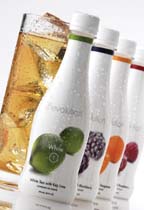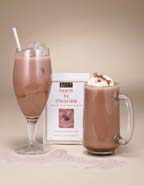
Regulatory and scientific advancements are making it possible to take an ordinary food, add some ordinary ingredients and turn it into one "extraordinary" new product. The ordinary ingredients referred to are berries, chocolate, nuts and tea. The ordinary food, which, we in the dairy industry know is anything but ordinary, is milk.
How is this possible? Well, for starters, science is showing us that each of these four common ingredients possess very healthful components ranging from antioxidants, which reduce the signs of aging, to omega-3 fatty acids, which have been found to reduce the risk of cardiovascular disease.
Then there's the regulatory component. As part of FDA's efforts to provide Americans with information to make better nutritional choices, the agency has made it easier for marketers to convey accurate, up-to-date and science-based information to consumers about the health consequences of consuming these ingredients, as well as others.
What FDA has done is developed a process for marketers to be able to make qualified health claims on products. The premise here is that a better-informed public is able to choose foods that are more nutritious, potentially addressing such urgent public health problems as the rise in obesity.
(On a side note, FDA sort of had to do this, as the former label claim process, which required all claims to be backed by significant scientific agreement, was found to be in violation of the first amendment. To overcome this violation, FDA decided to design a program that allows unproven claims to be made on foods, but with disclaimers designed to discourage the far-fetched ones.)
FDA has designed a process for systematically evaluating and ranking the scientific evidence for a qualified health claim. This ranking system categorizes the quality and strength of the scientific evidence to every proposed qualified health claim. The highest grade, A, means that there is significant scientific agreement about the health claim. The evidence supporting the claim is derived from well-designed studies conducted in a manner consistent with generally recognized scientific procedures and principles. Such a claim requires no disclaimer and is referred to as an "unqualified health claim." There are currently 12 such claims and descriptions of them can be found at www.cfsan.fda.gov/~dms/lab-ssa.html#regs.
Unqualified health claims are not new. What's new are the claims with grades B, C and D. These are "qualified health claims" because they require a disclaimer or other qualifying language to ensure that they do not mislead consumers. The grade of B is assigned to those petitions for which there is good scientific evidence supporting the claim, but the evidence is not entirely conclusive. A grade of C applies to claims for which the evidence is limited and inconclusive. The fourth level, D, is given to claims with little scientific evidence to support them. More information is available at www.cfsan.fda.gov/~dms/lab-qhc.html.

Beneficial ingredients
The nut industry was the first, and so far the only, to take FDA up on its qualified health claim offer. Ranked a B, packages of approved nuts can bear the claim: Scientific evidence suggests but does not prove that eating 1.5oz per day of most nuts as part of a diet low in saturated fat and cholesterol may reduce the risk of heart disease.What's special about nuts? Nuts are good sources of monounsaturated fat, protein, fiber, vitamins, minerals and phytochemicals considered to be beneficial for heart disease prevention, cholesterol lowering, cancer prevention and an adjunct to weight loss. Walnuts, specifically, also contain omega-3 fatty acids, which are heart protective and have been shown to improve heart circulation.
The nut claim cannot be made on foods that contain nuts, but the healthful halo does transfer over. Consumers may find a frozen dessert, particularly a frozen yogurt product more appealing when labels emphasize the inclusion of nuts.
Then there are berries. Strong-colored berries such as red raspberries and blueberries are recognized as being concentrated sources of antioxidants thanks to the high levels of the colorants called anythocyanins. In fact, compared to nearly 40 other fruits and vegetables, blueberries rank the highest in disease-fighting antioxidants.
An assay, called ORAC (oxygen radical absorbance capacity), quantifies the antioxidant-capacity of food. Blueberries provide 2,400 ORAC units per 100g. From an antioxidant capacity standpoint, 100g of fresh blueberries could deliver the equivalent antioxidant capacity of five servings of some fruits and vegetables. Furthermore, recent research shows that blueberries may act to protect the body against damage from oxidative stress, one of several biological processes implicated in aging and in the development of a number of neuro-degenerative diseases.
Blueberries, as well as other berries, are a favorite in dairy-based beverages, frozen desserts, smoothies and yogurt. In the produce section of grocery stores, pints of the fresh fruit often contain statements such as "rich source of antioxidants." Even blueberry juice packages have been seen with flags such as "The #1 Antioxidant Fruit." Dairy products can use similar language, too.
Let's move on to tea, the beverage of choice for health-conscious, on-the-go consumers. Tea is loaded with powerful antioxidants classified as polyphenols. Research indicates that the antioxidants in tea may inhibit the growth of cancer cells and support cardiovascular health.
Tea varieties are classified by the manner in which the leaves are processed after plucking. The four most common tea varieties are black, green, oolong and white.

Tempe, Az.-based Revolution Tea, recently rolled out the first unsweetened bottled White T ready-to-drink iced tea. Made from premium white tea and a splash of fresh fruit, this healthful beverage contains no calories, carbohydrates, sweeteners or preservatives. White T comes in four flavors: Blackberry, key lime, raspberry and tangerine.
Dairies can manufacture and bottle iced tea, too, using the same equipment that pasteurizes and bottles fluid milk. Tea can also be blended with milk to make drinks such as chai, a centuries-old Asian beverage that is typically served hot, but since being modernized, is frequently consumed cold. It is a blend of milk, fine black teas, honey and a variety of spices, which vary by region and culture. Typically, cardamom, ginger and even pepper are used as spices.
Last, but not least, there's cocoa and chocolate. The antioxidants called flavonoids, which are particularly concentrated in dark chocolate, are associated with being good for the heart. The quality and quantity of flavonoids in raw cocoa beans are very high; however, the amount of flavonoids in chocolate products, including chocolate-flavored milk, depends in part on the quality of the cocoa or chocolate ingredient and on how the finished products are processed.
Wayne, N.J.-based Ecco Bella, which means "behold beautiful" in Italian, is a beauty products company that believes in the power of chocolate. In fact, the company, which previously focused solely on cosmetics, now makes edible chocolate products promoted with phrases such as "the most decadent way to soft, smooth, luxurious skin" and "delicious Swiss chocolate with antioxidants for beautiful skin."
Branded Health By Chocolate, the product comes as either a drink mix for blending into milk or in candy bar form. Both products are based on organic cocoa, and infused with cranberry seed oil for omega-3 fatty acids, plus blueberry extract (there's that synergy again), lutein, lycopene and fiber.
As you can see, marketers of other products are openly touting the benefits of the ingredients they are made with. Dairy foods can, too.
